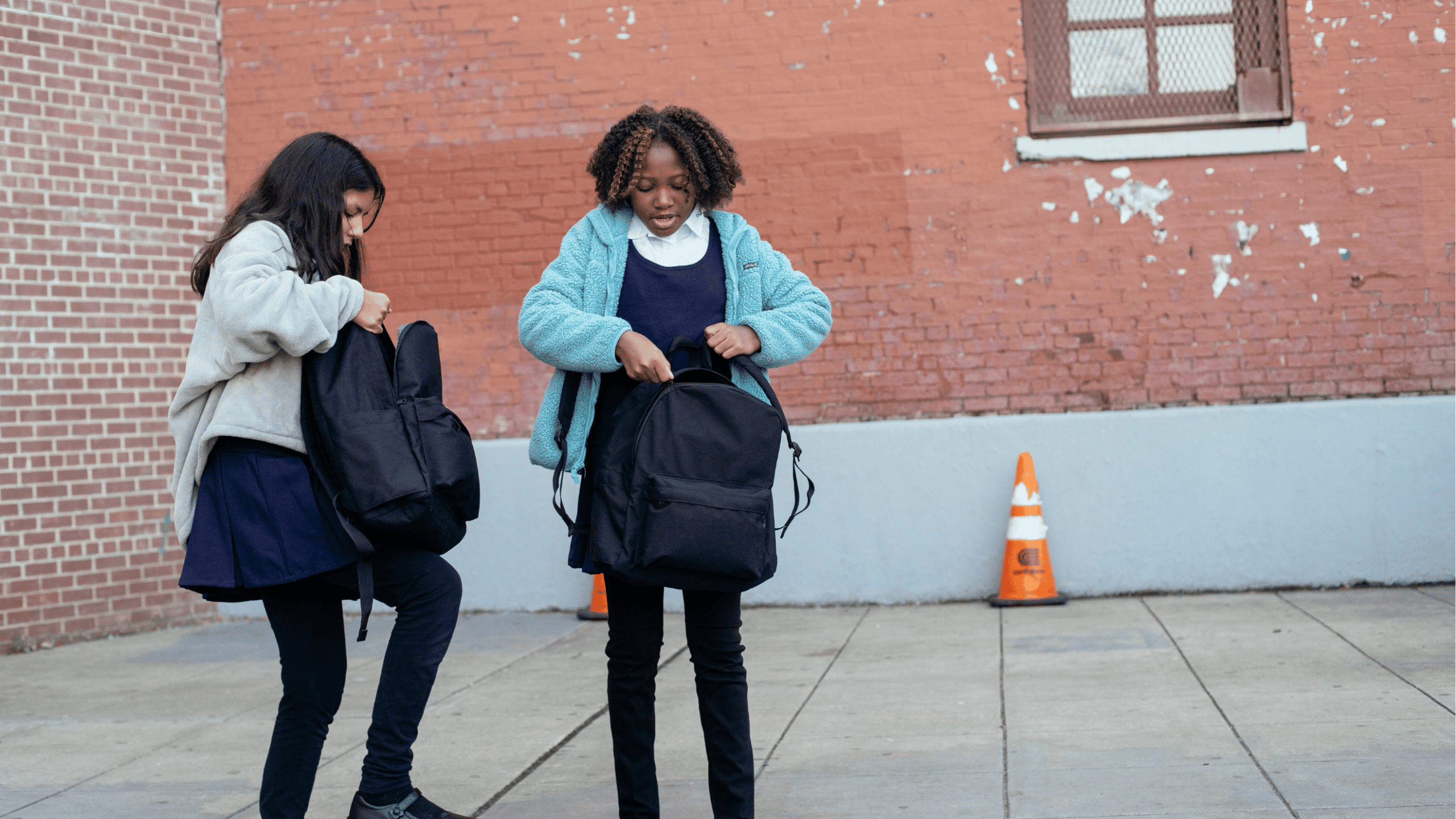
Does a heavy school bag cause back pain?
School bags have taken the brunt for years when it comes to the culprit behind back pain in children and adolescents. Recommendations have been presented in the past that school bags should not exceed 10% of a child’s weight, or they may risk developing back pain.
Especially in teenage years, when textbooks seem to double in size, and teens develop a wilful preference to have one strap slung over their shoulder as they swagger out of the house. You wouldn’t be alone in worrying about if that will cause them to get back pain. I mean, there’s two straps for a reason, right?
So, it’s time to own up. How often are you weighing your child’s bag before they head off to school?
If your answer is rarely or never, you’d be happy to hear that is perfectly fine.
No links between heavy school bags and back pain in children and adolescents
Recent systematic reviews and meta-analysis’ show that there is no clear association between heavy school bags and low back pain in school children. In fact, there are also no clear associations as to what type of bag they have, or how they might wear it. (2, 5, 7, 8, 10)
Now this isn’t to say that school bags can’t have an influence on back pain altogether, it’s just that we can’t point to them as the main culprit. There may be links with time spent carrying a school bag for example if there is a long commute, or perceived weight of a school bag. For example if a child feels that it is an extreme effort to carry, which may suggest that they need to build on their strength. (4, 9)
So then what are the factors that contribute to back pain?
It’s complex. There are many things that influence back pain unrelated and on occasion related to school bags. (1, 3, 5, 6, 7)

What are the risk factors for back pain in children and adolescents?
We now know low back pain is complex. We know that most of the time it isn’t a single injury causing back pain, but rather that it develops over time, with a many factors at play:
- poor mental health (anxiety, depression, low self-esteem)
- low or excessive activity
- female
- carrying back pack for >30 minutes daily
- taking an inactive form of transport to school (car/bus)
- watching television for longer periods of time
What’s with all the fuss about back pain anyway?
Many people think that pain doesn’t really happen too often in children and adolescents anyway. However, the rates of low back pain are higher than you might think.
- Low back pain affects 3-4 in every 10 children/adolescents at any point in time. (7)
- 30-50% will have pain that persists beyond 3 months, occurs on a regular basis and impacts important day-to-day activities such as school and participating in physical activity. (7)
This poses many questions knowing it is far more common than previously thought, and has a greater impact on the youth of today. If children and teenagers experiencing back pain understood the complexity of their pain, what influence would that have to back pain later in adulthood which costs the Australian health system $4.8 billion each year?

How can I prevent back pack related Pain in my child/teen then?
Asking how your child or teen feels about the weight of their school bag is important. If they perceive that it is heavy, it is more likely to influence the occurrence of back pain.
If they do feel it is too heavy – are there things that might be causing this to do with your child’s physical capacity? When we think about physical capacity, it means muscle strength, endurance, how muscles work relative to bone length. We understand that through growth periods, bones grow quickly and muscles can take time to strengthen. For females going through adolescence, overall mass increases before strength increases later in puberty. All of these factors play a part in how heavy a bag may feel.
Has your child recently had a holiday period of less activity or not really carrying anything except the odd shopping bag. This may reduce their physical capacity or tolerance of carrying a school bag.
So how do we build on physical capacity?
Increase general daily activity levels. There is no easy way of doing this for a busy family with many demands at once. It can often take a shift of the entire family to spend more time outdoors or allocating time after school or on weekends to go for family walks or spending time at local community parks, beaches or recreational spaces.
At times, a paediatric physiotherapist can help if there is pain limiting activity or if finding the right activity for your child/teen is difficult.
What about in the case of too much activity?
For some children and teenagers, the culprit may not be reduced physical capacity. But rather, there is too much activity, or what we call load. Load is a term for activity frequency, intensity and how long activity is performed. Now, a school bag can add to this load.
In this case, evidence suggests back pain can be linked with participating in a high level sport, highly technical sports or even linking with hyperactivity disorders. (1, 3, 5, 6, 7). Generally, having a diversification of sports can assist with providing varying loads and off-season periods

The balancing act between physical capacity and load can be a factor to the presence of back pain.
What do I do if my child or teen does have back pain?
Back pain in children and adolescents can come and go and be normal. Like all body-parts, pain can occur following activity and doesn’t need investigation or management. For example, after a day of cross country sore legs can be normal.
There are times though that getting help is important:
- If your child wakes up with back pain in the night
- If there has been weight loss or fevers associated with back pain
- Back pain or back stiffness occurs in the morning
- If the back pain is limiting or stopping your child from doing day-to-day activities or the things they enjoy
- If the back pain is not resolving over time
- You or your child/teen are concerned about their back pain and need direction on what to do
A paediatric physiotherapist will be able to engage your child in assessing and understanding the factors that may be at play and causing their back pain. Then addressing these factors is important in getting back to what they love.
References
- Aartun, E., Hartvigsen, J., Wedderkopp, N., & Hestbaek, L. (2014). Spinal pain in adolescents: prevalence, incidence, and course: a school-based two-year prospective cohort study in 1,300 Danes aged 11–13. BMC musculoskeletal disorders, 15(1), 1-8.
- Calvo‐Muñoz, I., Kovacs, F. M., Roqué, M., & Seco‐Calvo, J. (2020). The association between the weight of schoolbags and low back pain among schoolchildren: A systematic review, meta‐analysis and individual patient data meta‐analysis. European Journal of Pain, 24(1), 91-109.
- Hartvigsen, J., Hancock, M. J., Kongsted, A., Louw, Q., Ferreira, M. L., Genevay, S., … & Woolf, A. (2018). What low back pain is and why we need to pay attention. The Lancet, 391(10137), 2356-2367.
- Haselgrove, C., Straker, L., Smith, A., O’Sullivan, P., Perry, M., & Sloan, N. (2008). Perceived school bag load, duration of carriage, and method of transport to school are associated with spinal pain in adolescents: an observational study. Australian Journal of Physiotherapy, 54(3), 193-200.
- Frosch, M., Mauritz, M. D., Bielack, S., Blödt, S., Dirksen, U., Dobe, M., … & Zernikow, B. (2022). Etiology, risk factors, and diagnosis of back pain in children and adolescents: evidence-and consensus-based interdisciplinary recommendations. Children, 9(2), 192.
- Joergensen, A. C., Hestbaek, L., Andersen, P. K., & Nybo Andersen, A. M. (2019). Epidemiology of spinal pain in children: a study within the Danish National Birth Cohort. European Journal of Pediatrics, 178, 695-706.
- Kamper, S. J., Yamato, T. P., & Williams, C. M. (2016). The prevalence, risk factors, prognosis and treatment for back pain in children and adolescents: an overview of systematic reviews. Best Practice & Research Clinical Rheumatology, 30(6), 1021-1036.
- Oka, G. A., Ranade, A. S., & Kulkarni, A. A. (2019). Back pain and school bag weight–a study on Indian children and review of literature. Journal of Pediatric Orthopaedics B, 28(4), 397-404.
- O’Sullivan, P. B., Beales, D. J., Smith, A. J., & Straker, L. M. (2012). Low back pain in 17 year olds has substantial impact and represents an important public health disorder: a cross-sectional study. BMC public health, 12(1), 1-8.
- Yamato, T. P., Maher, C. G., Traeger, A. C., Wiliams, C. M., & Kamper, S. J. (2018). Do schoolbags cause back pain in children and adolescents? A systematic review. British Journal of Sports Medicine, 52(19), 1241-1245.
Authored by Rowan Pearce. Acknowledgement to Nicole Pates for references.






